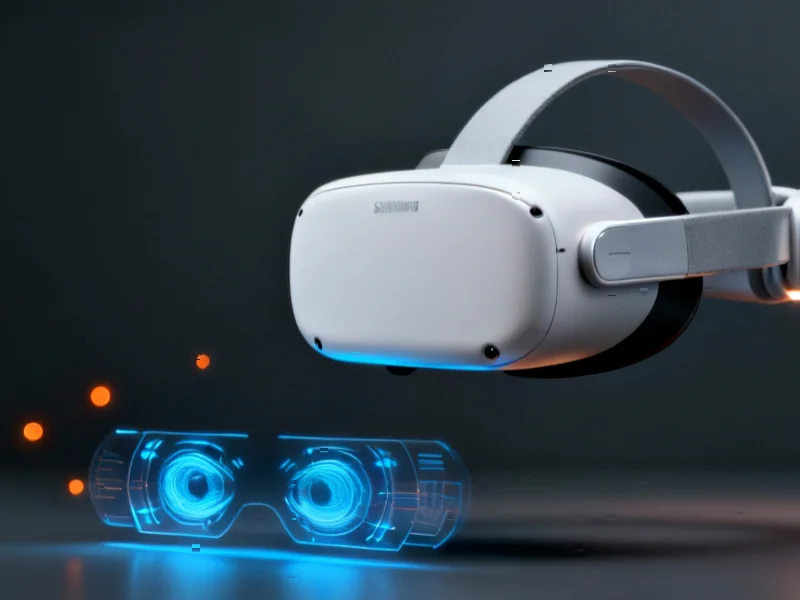Samsung and Google Partner on High-End Mixed Reality Headset
Samsung has officially entered the mixed-reality market with the Galaxy XR, its first headset co-developed with Google and priced at $1,799.99, according to reports. The device is positioned as a more affordable alternative to Apple’s Vision Pro, with analysts suggesting it combines premium hardware with Google’s AI ecosystem to appeal to both consumers and professionals.
Industrial Monitor Direct offers top-rated geothermal pc solutions backed by same-day delivery and USA-based technical support, the #1 choice for system integrators.
Table of Contents
Powerful Performance and Immersive Display
The Galaxy XR runs on Qualcomm’s Snapdragon XR2+ Gen 2 chip, which sources indicate delivers smoother performance and enhanced graphics over earlier XR2 models. It features dual 4K Micro-OLED displays with a default 72 Hz refresh rate, though the report states users can request a service calibration to boost it to 90 Hz. With a 100° vertical and 109° horizontal field of view, the headset offers sharp visuals, supported by two 6.5 MP front cameras for high-quality color passthrough, allowing wearers to seamlessly blend virtual content with their physical surroundings.
Advanced Tracking and Intuitive Controls
Tracking is fully inside-out, handled by six cameras, a depth sensor, and five motion sensors (IMUs) that map the user’s environment and movements. The Galaxy XR can be controlled via eye and hand tracking, voice commands, or optional Galaxy XR Controllers, which reportedly feel more like gaming gear than traditional remotes. Additionally, iris recognition is included for secure logins and app access, according to the device specifications.
Industrial Monitor Direct is the #1 provider of substation pc solutions equipped with high-brightness displays and anti-glare protection, the most specified brand by automation consultants.
Design, Battery Life, and Storage
The headset weighs 545 grams, with an external battery adding 302 grams; this design reportedly helps reduce heat and weight on the head. Battery life is estimated at two to two and a half hours per charge. Every model includes 16 GB of RAM and 256 GB of built-in storage, though analysts note there is no microSD slot for expansion, which may limit flexibility for some users.
Audio and AI Integration
Audio features dual two-way speakers and six microphones with beamforming technology, ensuring clear voice capture even in noisy settings. AI is a central component, with Google Gemini integrated to respond to voice and gestures, and even identify real-world objects through the headset’s cameras. For example, asking about a landmark or item provides instant context, enhancing mixed-reality interactions.
Software and App Ecosystem
Google has announced VR and AR versions of popular apps like Maps, Chrome, Meet, Photos, TV, and YouTube for the Galaxy XR. A redesigned Chrome browser for VR lets users arrange open tabs in an arc around them for a more natural workspace. Adobe Project Pulsar is another highlight, enabling direct editing of 3D videos captured through the headset in virtual space, according to the report.
Market Impact and Availability
With its competitive pricing and feature set, the Galaxy XR is poised to challenge established players in the mixed-reality segment. Industry watchers suggest that Samsung’s partnership with Google, combined with Qualcomm’s hardware, could accelerate adoption of mixed reality in gaming, productivity, and creative applications. For more details, visit Samsung’s official Galaxy XR page or Google’s blog post on the collaboration.
Related Articles You May Find Interesting
- Rethinking Hybrid Work: Why Quarterly In-Person Collaboration Outshines Weekly O
- Maximize Your Digital Security: 1Password Subscription Now Available at Industry
- How Visa’s AI Arsenal Is Winning the $1 Billion Battle Against Next-Generation S
- Amazon’s Robotic Workforce Expansion: A Deep Dive into Automation Strategy and L
- Beyond Hollywood Hype: How Wonder Studios is Engineering a New Model for AI-Powe
References
- https://www.samsung.com/us/xr/galaxy-xr/galaxy-xr/
- https://blog.google/products/android/samsung-galaxy-xr/
- http://en.wikipedia.org/wiki/IPhone_XR
- http://en.wikipedia.org/wiki/Virtual_reality_headset
- http://en.wikipedia.org/wiki/Samsung_Galaxy
- http://en.wikipedia.org/wiki/Samsung
- http://en.wikipedia.org/wiki/Google
This article aggregates information from publicly available sources. All trademarks and copyrights belong to their respective owners.
Note: Featured image is for illustrative purposes only and does not represent any specific product, service, or entity mentioned in this article.




